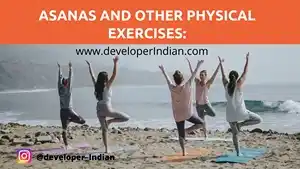Asanas and Other Physical Exercises
#Asanas and Other Physical Exercises #yoga #Asanas
Asanas and Other Physical Exercises:
As we know, in the physical cultural, heart has to do extra amount of work to get rid of impure blood resulting in the increased heart rate. This does not apply in the case of Asanas. Hence, there should be at least 30 minutes gap between Asanas and other type of physical exercises.
Asanas and Physical Efficiency:
The question is common: What is the effect of Asanas on Physical efficiency? It has been clearly stated in Hatha Pradipika that Asanas bring mental as well as physical steadiness, health and a feeling of lightness(H.P. 1\17).
Our experiments in the laboratory also have proved that the efficiency of the body and concentration of mind increase by the practice of Asanas.

Asanas and the welfare of sportsmen:
The main goal of Asanas is not to prepare sportsman and women at national or international level but efficiency certainly, it has been seen to increase their efficiency, flexibliity, concentration and strength. Our sportsman could also be benefitted by Asanas if other situation are normal. It is popularly said that a person doing sirsasana for an hour can turn the colour of his grey hair into black provided the rest of 23 hours are also disciplined. The same is applicable especially for sportsman or women and people in general. If one wants to be benefited by Asanas and Pranayama one should lead a disciplined life.
LIMITATION FOR WOMEN IN YOGA:
Which Asana are not to be done by women and when? Normally, during the first three month of pregnancy Uddiyana, Pascchimotasana, Yoga-mudra, Ardha Matsyendrasana and all those Asanas which give pressure in the abdominal region should be avoided by women. So also, during menstrual periods no Asana shouls be practised by women,
because the undue pressure exerted during Asanas may cause increased bleeding. And women should practice Mayurasana only under proper supervision and guidence of a trained teacher.
In the end, the Appendix has been provided, giving the proper yogic terminology, i.e.. the Nadis, the different aspects of Astanga Yoga Chakras, Vayus, etc, so that student of Yoga may become familiar with them which will facilitate their further study and practice of Yoga in future.
Even though we have tried to present the maximum material to help the students of Yoga, it cannot be claimed to be complete in every respect. We pray to our readers to excuse our limitations and request them to send us their suggestion for improvement of the book in the next edition.
Table of content
- Introduction to Yoga
- Yoga Asanas and Benefits
- Yoga and Lifestyle
- Popular Yoga Asanas